Vancouver recommendations?
Vancouver recommendations?
-
-
-
-
-
-
Post #31 - March 5th, 2008, 5:16 pmI have been out here for a year working and have meant to write on a few of my favorites. I’ve been waiting for work to subside enough to devote the proper attention to the subject, but I fear that day may never come. So, in the interest of brevity, here a few memorable bites I’ve had in this blessed city, and where I was lucky to find them. These suggestions are largely within the city core as that is where I live and work sans automobile. That situation is changing, and the real frontier lies beyond the city in Richmond (for Chinese) and Surrey (for Indian), where I have not yet begun to scratch the surface. Sorry, no photos.
Pork jowl don-toro at Guu (Gastown location). My home base Guu is the West End Thurlow location, where the fun, energy and intimacy make it my favorite izakaya place in Vancouver. However it is at the Gastown location where I enjoyed the single finest plate in the Guu mini-empire. Rich but meaty pork jowl lightly grilled and dressed unfussily with a tumble of chopped scallions and a drizzle of ponzu. I love it when a bite of food makes me close my eyes and chew slowly. This always does.
#105-375 Water Street
604-685-8682
www.guu-izakaya.com
Pork cutlet tonkatsu at Dae Ji Pork Cutlets. Obscurely named and tucked away on a pedestrian stretch of Dunsmuir, you probably won’t find this place unless you stumble across it like I did. This is a shame, because no-one does a better version of tonkatsu in town. Tenderloin is butterflied, pounded, seasoned and dredged in panko before being fried to a perfect golden crunch. It is hang-over-the-edges-of-the-plate big, but they find room for a dollop of spicy macaroni salad, white rice and lightly dressed cabbage. It’s a Hawaiian plate lunch take, but the reverence with which the pork is treated elevates it to something more special.
Dunsmuir between Seymour and Richards…Phone # Unknown
Mussels and frites at Chambar. Faced with a choice between Chambar and Vij’s, only a toss of a coin can determine my favorite restaurant in Vancouver on any given day. As I think about the moules frites and fries in this cheerfully noisy and warm environment, I am leaning toward Chambar--particularly when the pairing mentioned above is preceded by a Booker Vice, a cocktail of eponymous bourbon, muddled white corn and buckwheat honey with a squeeze of orange slice. One of my favorite places in North America.
562 Beatty Street
P: 604 879 7119
www.chambar.com
Chicken wings at Phnom Penh. Julia Child sang the praises of this place back in the 70s or 80s, and it has been a regular stop for out-of-towners ever since. I find most of their offerings to be just so, but the wings are what still get the locals to head to this place on a sketchy side street off a sketchy part of Main Street. Breaded, fried and tossed with sweet garlic, jalapenos and cilantro, these are best finished off with a dunk of lime pepper sauce. A generous order of these and a Tsing Tao or three will vanish astonishingly fast.
244 E Georgia St.
Tel: 604 682-5777
Pane romano at Sciue. Observers are quick to crown Vancouver as a chowist, LTH-ish destination of the highest order, but for the uninformed or overly optimistic, serious disappointment awaits at every turn. The state of pizza in Vancouver is one such example. This won’t prevent helpful natives from suggesting a sampling of this place or that; an urge that should be resisted at all costs, unless that suggestion happens to be Sciue. What Sciue does is very different than what your typical Chicago or New York joint will turn out in consistently excellent lots, but this is the compromise you are faced with should your thoughts turn to pizza while you’re here. Established by a couple of enterprising Romans, they preach the virtues of “Roman street food”. Having never been to Rome, I can only take this phrase to mean “incredibly delicious open-faced sandwiches that want to be pizzas”. Better known as pane romano, these are served and charged by the gram, which seems an infinitely sensible way to curb the urge you will have to eat these until you explode. Varieties are almost endless, and I haven’t had a mediocre one yet.
800 West Pender
604-602-7263
www.sciue.ca
Oven-Roasted Beef Bone Marrow, Served with Seasonal Salad, Fresh Tomato “Fondant”, Toasts and French Sea Salt at Le Crocodile. Anthony Bourdain’s idea of a perfect last meal, this version from old school French stalwart Le Crocodile is simple and extravagant. Unctuous and unendingly rich, this marrow makes pork belly look like a boneless skinless chicken breast. It is best washed down with glass upon glass of the most austere Bordeaux on the menu.
909 Burrard
604-669-4298
www.lecrocodilerestaurant.com
Black pepper chicken at Kam’s. Billed as Malaysian/Singaporean, Kam’s manages to do neither quite well, and that’s okay. Everyone in Vancouver has a favorite white carton Asian place that hits the spot after a night of drinking or serves as a fast take-out option after work. Hon’s Won Tun gets many votes in this category, but Kam’s gets mine. Chunks of moist chicken in a light sauce shot through and through with fresh ground black pepper is simple and comfortable. Honourable mention: an appetizer of breaded and fried pork tenderloin strips are served with big crystals of kosher salt clinging to them, and will cure a hangover efficiently.
1043 Davie
604-669-2883
Roti canai at Banana Leaf (Broadway location). I am in the process of losing about 10 pounds I have packed on in the last year. I would lay the blame for perhaps a third of this weight gain to the roti at Banana Leaf. Of the three locations, Broadway serves the best, but all are great. Fluffy, but also moist and dense, dipped in a mild curry sauce. Proceed with caution.
820 West Broadway
604-731-6333
www.bananaleaf-vancouver.com
Chili crab at Prima Taste. There is a particularly repulsive commercial currently being aired in the Seattle market celebrating the return of the chili cheeseburger to Carl’s Junior. In it, a high school kid is attacking one while his girlfriend looks on. She observes that he has something on his face, the set-up for a payoff that shows his entire maw caked with “delicious” Carl’s Junior chili. Watching it brings to mind one of my first days in town last January. I was staying at the Westin near Yaletown, and during a surveillance visit to nearby Prima Taste, the affable owner gave me the hard sell on the Malaysian chili crab. Listed at “market price” on the menu, I questioned his (profit) motives, but his persistence and willingness to box up an order to go, replete with shell-cracking implements (“you return tomorrow!”) tipped the balance in his favor. Well, that and the fact that I was still on a generous expense account. Back in my temporary digs upstairs, an initial attempt at circumspection gave way to something resembling a frenzy once I began tasting the chunks of assertively hot Dungeness crab. I was happy when the allotment of napkins gave way and I could focus solely on extracting meat from shell…by any means necessary. I felt like a wolverine over a fresh kill. I felt like a predator. This is what chili crab will do to you. I have since sampled and enjoyed it at Banana Leaf, the other “authentic” Malaysian place in the city core, but Prima Taste is where I have returned. Honourable mention: black and white rice; rum cocktail called “The Robson”.
570 Robson St.
604-685-7881
Oroshi dog at Japa-Dog. On the Burrard sidewalk near the front of the Sutton Place Hotel is where Japa-Dog transacts from a modest cart on a rain or shine basis. Japanese style hot dogs and sausages are the offerings, and they have taken the idea to an art form. They have also become something of a mania back in Japan, if the breathless and largely incomprehensible newspaper clippings on the cart are to be believed. I alternate between the oroshi and terimayo dogs; the former is a bratwurst in a standard sausage roll dressed in a thick soy-based sauce with green onions and daikon. The latter is a beef hotdog with seaweed, fried onions and mayo. Both have a robust casing that lends a satisfying snap. This might present challenges to mobile, one-handed dining while wielding an umbrella against pelting rain if the helpful folks at Japa-Dog didn’t cut each link nearly all the way through in neat, bit sized sections. Honourable mention: check out japadog.com for some adorable examples of “ingrish”, beginning with the following disclaimer: “Our English is very poor. The followings may make mistakes. We are sorry.”
Ceviche at Lolitas. What I mentioned above concerning the state of Vancouver pizza also applies to the state of Mexican food. In Chicago, we are similarly blessed with great choices, but even in that context, I had given up on ever finding passable options. This sorry state of affairs is typified by two repugnant chains doing business as Steamrollers and Taco del Mar. Both should have their licenses revoked in my opinion. But there are so many more offenders, which made the discovery of Lolita’s all the better. Situated in the heart of flamboyant Davie street (the land of the pink bus stops), Lolita’s serves up Frontera-esque Mexican staples (sorry, no burritos) but with a slight pan-Latin fusion bent. An emphasis on seafood and thoughtfully composed umbrella drinks rounds out the tropical vibe of this intimate and cheerful setting. The place racks up local honours. I’m not sure if it’s destination dining for Chicago tourists, but it gets me by. Honourable mention: carne asada tacos and the salsa trio with chips.
1326 Davie
604-696-9996
www.lolitasrestaurant.com
Lamb popsicles at Vij’s. Vij’s. I love everything about this place. I love that it’s on the way home from the airport, which has made it the de facto first stop and happy reunion place for visiting friends and relatives. I love the no-reservation policy, which necessitates cooling your heels in the comfortable lounge area drinking wine and snacking on papadums and other complimentary noshes that keep the wait bearable. I love the owner Vikram Vij, ever-resplendent in various brilliantly colored kurtas, working the front of the house graciously and warmly. I love his cookbook. I love his adjacent packaged foods location, which enables me to enjoy a reasonable facsimile straight from the fridge. More than anything, I love the lamb popsicles with fenugreek cream sauce. Honourable mention: everything.
1480 W. 11th Ave.
604-736-6664
www.vij’s.ca
I am only halfway through the list I scrawled out on the back of an envelope this morning. In a future post, maybe I’ll get to the shrimp ball crusted in crunchy almond slivers at Imperial, or the prawns in chiang mai sauce at Thai House, or the chicken shawarma at Falafel Maison, or the beef carpaccio at Il Giardino, or the blue cheese and chicken pizza at Numero Uno Pizza (I know what I said…I’ll explain later).
-
-
Post #32 - March 5th, 2008, 9:05 pmDe Dutch Pannekoek House is another great spot for breakfast. Dutch pannekoeks with various toppings are the signature dish. www.dedutch.com/
For an amazing variety of excellent gelato, LaCasa Gelato is a "must stop." Currently offering over 200 flavors. www.lacasagelato.com
Many food stores carry Mario's Gelati Calipops, a low-fat, non-dairy, natural juice, frozen novelty.
Highly addictive and not available in the U.S.Mark A Reitman, PhD
Professor of Hot Dogs
Hot Dog University/Vienna Beef
-
-
Post #33 - July 14th, 2008, 1:57 pmAs I previously posted in this post, my wife and I spent a week in Vancouver, checking out some of its culinary offerings in between some scenic excursions, both urban and outdoorsy. As I said in the prior post, the Xiao Long Bao at Chen's Shanghai Kitchen were the best thing we ate in Vancouver, but there were some other treasures worth sharing.
Chambar in the east part of downtown was one of our favorite stops. Imagine if Hopleaf offered some pricey, upscale-ish entrees in addition to the mussels/frites and Belgian brews. The mussels were excellent, the upscale entrees nicely prepared, but the drinks were the highlight.
Another upscale choice we enjoyed was Lift, located right on the harbor in the West End. The nigiri sampler appetizer was the best sushi we tried in Vancouver. The real allure of Lift is its setting, offering stunning views of the harbor and the mountains beyond. This picture was taken right outside its doors, but the views from inside are just as nice:
Another seaside destination is Go Fish at False Creek Fisherman's Wharf near Granville Island. It's a very popular fish and chips shack, and the signature dish did not disappoint. Here's the cod and salmon combo:
and even better was the cone-shaped salmon taco ("tacone")--fresh salmon with a smokey grilled flavor and a cilantro-y dressing:
Yet another seaside locale was Deep Cove, which is not highly touted in the guidebooks, but is a very appealing little nook.
If you do make the long trek out to Deep Cove, don't miss Honey Doughnuts, for their warm, soft, sticky namesake:
Another dessert treat has been mentioned earlier in this thread is La Casa Gelato. The rumors of 200+ flavors are true! I tasted a few unusual ones, including garlic, black sesame and wasabi.
I mentioned Peaceful Restaurant in the XLB thread, but the XLB were the third-best thing we tried there. The beef roll appetizer was outstanding--very thinly sliced beef, a little hoisin sauce and some cilantro rolled into a thin and crispy green onion pancake. Wow.
Peaceful is also home to some great hand-pulled noodles. Reminded us a lot of Katy's noodles, but if I had to choose, I'd say Katy's delivers a better bowl than Peaceful (no shame in that, of course)
We read a lot about the izakaya scene in Vancouver, but were generally not excited by the places we tried. Not bad, really, but a little more schticky and less chow-y than we'd hoped.
A nice sashimi dish at Hapa:
Tower of wings at Guu With Garlic:
Vancouver is always ranked near the top of most livable cities in the world, and I can see why. The people are friendly and they have a lot of great scenery and some serious chow to boot. But this place on Denman Street reminded us that there really is no place like home:
Chambar
562 Beatty Street, Vancouver
604-879-7119
Lift Bar Grill View
333 Menchion Mews, Vancouver
604-689-5438
Go Fish @ False Creek Fisherman's Wharf
1505 W 1st Ave., Vancouver
604-730-5040
Closed Mondays
Honey Doughnuts
4373 Gallant Ave., North Vancouver
604-929-4988
La Casa Gelato
1033 Venables St., Vancouver
604-251-3211
Peaceful Restaurant
532 W. Broadway, Vancouver
604-879-9878
Hapa
1479 Robson, Vancouver
604-689-4272
Guu With Garlic
1698 Robson, Vancouver
604-685-8678
-
-
Post #34 - July 20th, 2008, 8:11 pmI really appreciate the recommendations here. We followed one last night and had what can only be described as a stunning meal at Kirin . . .

Kirin in Vancouver is located at 1166 Alberni Street, Vancouver, B.C., Canada V6E 3Z3. They have 3 other locations.
Seafood Appetizer Platter - half order
This was an amazing array of immaculately fresh delicacies, which included jellyfish in the center, fried squid to the left of that, smoked salmon at the top of the plate, smoked eel to the right of that and scallops with spicy black bean sauce at the bottom of the plate.
Smoked Eel on the Seafood Appetizer Platter
This was my favorite item on the platter.
Smoked Salmon on the Seafood Appetizer Platter
I enjoyed this tender, meaty salmon almost as much as the eel.
Next up, we took advantage of the 'live tank' offered at Kirin. This bad boy, which they placed on the table to amuse my son, weighed in at about 3.5 pounds. Several preparations are offered and because of my son's palate, we chose one that we knew wouldn't be too spicy.
Lobster with Scallion and Ginger
After a relatively short wait, our friend, now transformed, was returned to the table.
Lobster meat
He died a nobel death, as we finished every bit.
Hot & Sour Soup
This was a delicious, distinctive version in which the hot and sour were both amped up but still extremely well-balanced. From what I could tell, it contained shrimp, pork, tofu, black fungus, carrot, scalion, egg and who knows what else. Very complex and deep in flavor.
Sauteed Green Beans with Spicy Pork Sauce
Spectacular dish that I could eat over and over again. The green beans were cooked just beyond al dente and the spicy pork sauce was out of this world.
Smoked Duck
You can probably tell just from looking at the moist, red meat how smokey and delicious this duck was. The skin was supremely crispy and I could barely stop eating it, long after I was full. It was served with plum sauce and miniature steams buns (which you can see on the plate), so making a few little duck sandwiches was in order. These buns, other than their smaller size, were identical to the ones that Sun Wah in Chicago serves with their Beijing/Peking Duck.
I was blown away by this meal. And possibly even more impressive than what we did order were the items we had to leave unordered. The menu is large and contains so many exotic ingredients like abalone, shark fin, sea cucumber, pork hock, fish maw and many others. We were only group of 3, so we did what we could but still had to bring leftovers back to the hotel. I wish we had been part of a larger group, though, so we could have tried more items. In any case, if any LTH'ers are headed to Vancouver, I cannot recommend Kirin highly enough.
=R=
Kirin Restaurant
1166 Alberni Street
Vancouver, B.C.
Canada V6E 3Z3
604 682-8833By protecting others, you save yourself. If you only think of yourself, you'll only destroy yourself. --Kambei Shimada
Every human interaction is an opportunity for disappointment --RS
There's a horse loose in a hospital --JM
That don't impress me much --Shania Twain
-
-
Post #35 - July 20th, 2008, 11:02 pmGreat pics, as usual, Ronnie. We visited the City Square location of Kirin for dim sum while we were in Vancouver. We thought it was above-average, for certain, but didn't fall in love with the place. Judging from your photos, I think that maybe we ordered a little too conservatively.
The chili oil was lovely:
Deep-fried spareribs were a little chewy, but hard to stop eating:
And other items were well-prepared versions of dim sum stand-bys:
Please keep reporting on your adventures up there!
-
-
Post #36 - July 22nd, 2008, 12:33 pmtapler wrote:Please keep reporting on your adventures up there!
Will do.
We had a delightful dim sum brunch at Sun Sui Wah on Sunday. Being a Sunday morning, we decided to call in advance and get a reservation before heading in. When we arrived at about 12:15, the place was full but not jammed. Walk-ins were being seated fairly promptly and our reservation was honored without delay.
I'm certainly no expert with dim sum but for me, this was some of the finest dim sum I've ever had . . .
Sun Sui Wah is located at 3888 Main Street in Vancouver, BC, Canada
The vast space is well-lit via the use of massive skylights
Before we could even get our butts in our chairs, the carts started rolling by. The items continued to be delivered, fast and furious. Unfortunately, our eyes were bigger than our stomachs but everything looked so good, it was hard to say no . . .
Steamed Shrimp Dumplings
Pork Shumai
Fried Spring Roll
Fish Cake atop Green Pepper
Fried Pork Dumpling
Noodles with Scallions
Rice Packets
Rice, Chinese Sausage and Ground Meat
Turtle (with Taro, iirc)
Meatballs
Braised, Steamed Pork (parts unknown) with Fermented Black Beans
Mushrooms in Flat Noodle
Most Glorious Shrimp Toast
Another look at the Shrimp Toast
Asparagus Wrapped in Shrimp Paste
Bao with Sweet Pork
Jello (there's always room for it )
)
Mango Pudding with Sweetened Condensed Milk
This is a great spot and one that should not be missed. There may be better dim sum in Vancouver but this was as good as any I've had in Chicago. If you get a chance, I highly recommend checking it out.
=R=
Sun Sui Wah
3888 Main
Vancouver, BC V5V 3P1, Canada
604 872-8822By protecting others, you save yourself. If you only think of yourself, you'll only destroy yourself. --Kambei Shimada
Every human interaction is an opportunity for disappointment --RS
There's a horse loose in a hospital --JM
That don't impress me much --Shania Twain
-
-
Post #37 - July 22nd, 2008, 4:08 pmBeautiful pics! What's not to like about a place that combines the names of two of my favorite Chinese restaurants in Chicago into one glorious dim sum orgy?Steve Z.
“Only the pure in heart can make a good soup.”
― Ludwig van Beethoven
-
-
Post #38 - July 23rd, 2008, 1:09 amRon,
Terrific pictures, all look delicious, but the asparagus wrapped in shrimp paste is speaking to me (eat me, eat me) and turtle with taro sounds, and looks, intriguing.
Enjoy,
Gary
-
-
Post #39 - July 23rd, 2008, 1:27 amG Wiv wrote:Ron,
Terrific pictures, all look delicious, but the asparagus wrapped in shrimp paste is speaking to me (eat me, eat me) and turtle with taro sounds, and looks, intriguing.
Enjoy,
Gary
Thanks, Gary. That turtle cake was dense, meaty and somewhat sweet. I can't really describe the way it tasted beyond that. The actual chunks of turtle meat had the consistency of organ meat. It was quite tasty.
I think my 2 favorites were the odd pork parts and the shrimp toast but everything except for the bao was fantastic.
=R=By protecting others, you save yourself. If you only think of yourself, you'll only destroy yourself. --Kambei Shimada
Every human interaction is an opportunity for disappointment --RS
There's a horse loose in a hospital --JM
That don't impress me much --Shania Twain
-
-
Post #40 - June 9th, 2009, 7:17 pmOK - just booked in my Vancouver vacation for five nights next month. Any new recommendations?Never order barbecue in a place that also serves quiche - Lewis Grizzard
-
-
Post #41 - February 3rd, 2010, 7:38 amOK - for my next trip - http://www.nytimes.com/2010/02/03/dinin ... .html?8dpcNever order barbecue in a place that also serves quiche - Lewis Grizzard
-
-
Post #42 - February 4th, 2010, 5:23 pm
I'm way overdue in posting about my trip several months back. Given that it gets less likely with each passing day that I'm going to craft a long post, complete with photos, here are my thoughts on Vancouver dining and drinking based on a four day visit:Dave148 wrote:OK - just booked in my Vancouver vacation for five nights next month. Any new recommendations?
Fuel was our (mine and RAB's) favorite meal in Vancouver. It's a high-end farm-to-table restaurant. We went with the seven course option and were exceedingly pleased with the food across the board. They served perhaps the best charcuterie platter I've ever had in a restaurant. Another winner was seared tuna with heirloom tomatoes and bacon mayonnaise wrapped in thin bread. A third favorite was a slow-cooked pork shoulder for two with black truffle gastrique and cauliflower puree.
Vij's was a disappointment. 3+ hour waits on weekends, no reservations. We went on a Tuesday night and had a short wait. But, even that wait wasn't worth it for the food. It's just not interesting enough to justify the high cost. Sure, the lamb popsickles were tasty, and we enjoyed the locally-brewed Storm beer. Overall, though, we didn't enjoy our dinner half as much as Devi in Manhattan or Rasika in D.C.
For another dinner, we did a mini-izakaya crawl. I'd really recommend this. It was a blast. We went to three different Izakayas: Guu with Garlic (fun, funky, and loud), Kingyo (more upscale and quiet), and Zakkushi (with the budget-conscious crowd). At each place, we ordered a few plates and a few drinks. Best uni I've ever had at Guu - - melt in your mouth fresh, and tasting of the sea. I wouldn't recommend a crawl for a weekend because of crowds, though.
A final dinner was enjoyed at Kintaro for ramen. They only serve ramen. You pick how fatty you want the pork and what kind of broth you want (light, medium, dark and miso or shoyu). The ramen was reasonably-priced and satisfying. We were seated at a large round table with other diners. It was amusing to watch all conversation stop when the food arrived and all we heard instead was loud slurping. I have to admit that I'm not a huge fan of ramen and haven't had it many places. Sure, it was way better than Mitsuwa Market. But, I don't know if it was a great example of ramen.
I think we only had one memorable breakfast in Vancouver, at Medina. RAB didn't like this spot, both because they didn't serve drip coffee and because it seemed to be trying a bit too hard. That said, I thought the food was pretty good and if you're staying right downtown, Medina appears to be one of only a few interesting breakfast options. Their thing is fancy skillets. I had what they called a cassoulet fricasse. Good stuff.
We had a few enjoyable lunches. We tried Nuba, a small local Mediterranean food chain. The food is expensive for fast food, but everything is super-fresh and made to order. We enjoyed the lamb kibbeh and Najib's special fried cauliflower.
I felt like we had to try Japadog. RAB wasn't into it. It was ok. I enjoyed it, but didn't find it cravable.
Go Fish, near the Granville Market, OTOH, is very much worth seeking out. It's a small outdoor shack on the water. We had a great chipotle lime chowder, as well as the signature fried cod and chips. Speaking of the Granville Market, it's definitely worth a stop. We went to Oyama, the charcuterie stall, and asked them to give us four slices of six different meats. They were happy to do so. Trying the different charcuterie made for a wonderful snack.
And, finally, if you like beer, you must go to the Alibi Room. Great space, informed servers, and a wonderful beer selection, mostly from BC.
Safe travels,
Ronna
-
-
Post #43 - August 15th, 2010, 3:13 pmMight anyone have any experience of a place called Voya in the Loden Hotel?Gypsy Boy
"I am not a glutton--I am an explorer of food." (Erma Bombeck)
-
-
Post #44 - August 15th, 2010, 10:15 pmNo experience with Voya though I've considered the hotel several times but always end up with a good deal at one of the Fairmonts and they just do service so well.
We go to Vancouver a lot since we have a number of clients there and while I agree with all the great sushi recommendations (which a BC friend describes as BC cuisine), I also love some of the other options.
Banana Leaf - mentioned above remains fun and tasty. The owner of our company calls it his favorite in Vancouver since he loves Malaysian food.
Chambar - also mentioned above is a real gem but don't think of it as simply a belgian restaurant for mussels - they have a pretty diverse menu with a wonderful lamb tagine amongst other things - and a great Vancouver style scene. Folks head there for drinks as well as meals - it's a hang out as well as a great dining place and we've spent more than a few long fun evenings there, eating great food and talking for hours.
A colleague and I stayed at the Four Seasons one time and being really tired decided to simply eat at the hotel - which meant their restaurant Yew. We ended up eating there four times in three days - it was a really wonderful upscale resto with a very deft hand. Service superb, cocktails that match the inventions we all love in Chicago, and exceptional food from light to special event dining. It remains a wonderful option.
One of the best places I've eaten in Vancouver is Elixir Bistro in the Hotel Opus ... a client suggested it for lunch, I was not expecting to be impressed and then was knocked out. The chicken with rye spaetzle I want to eat every single day!
Along Water Street near Canada Place there are lots of small restaurants as well and you can happily pick almost any one and get a fun meal ... brewpubs, good Italian, etc. In the Sinclair Centre, there's a rather ugh food court but in the middle of it is a little French spot that does wonderful crepes. Lovely french couple who cook it all themselves and go out of their way to make you happy. Nood on Water St (New Objects of Desire) also has a neat selection of kitchen and dining tools.
One more suggestion - for an amazing time, take the Rocky Mountaineer Glacier Dome train to Whistler. On the Dome car (all glass) you are served nice wine (BC produces great wines - try the Tantalus Riesling but leave some for me!) and then Fairmont High Tea. Nothing can quite compare to a ride through the Tantalus Mountains while you can smell your fresh scones baking in the kitchen of your dome car ... And of course, Whistler itself is gorgeous in summer, has a great farmer's market and good restaurants.
Hmmm ... I think I may discover a need to visit some clients again soon!
Rocky Mountaineer Glacier Dome
http://www.rockymountaineer.com/
Chambar
604 879 7119
Chambar Restaurant
562 Beatty Street
Crosstown, Vancouver BC
Canada V6B 2L3
http://www.chambar.com
Yew at the Four Seasons
http://www.fourseasons.com/vancouver/di ... estaurant/
1 (604) 692-4939
Elixir at Opus Hotel
350 Davie Street
Vancouver, British Columbia
Canada V6B 5Z6
Tel: 604.642.0557
http://www.elixirvancouver.ca/contact.php
-
-
Post #45 - September 16th, 2010, 9:37 pmMy wife and I went to Vancouver with some friends in July.
Our first night in Vancouver we decided to do an izakaya crawl (as recommended by RAB and REB). The restaurants are all within five minutes walking of eachother so it’s a great way to spend a night. The first stop was Guu with Garlic. The atmosphere in the bar is very chaotic. Any time anything happens be it taking an order, busing a plate or picking up an order from the bar, one of the servers screams out something in Japanese. I can’t imagine the yelling serves any purpose other than to provide ambiance because the room is loud and constantly buzzing with servers. I have to say we were a little disappointed with the food. The agadashi tofu had good texture but didn’t have a lot of flavor in the broth and the udon with pickled vegetables had great noodles but the stir fry seemed a little plain and clumsy. We did enjoy the fried seafood wedges and the kim chi soup, but neither was a real standout. It was a quick little stop and the price was very reasonable, but it didn’t quite live up to the expectations we had going in. The second stop was Zakkushi. They specialize in yakitori (meat on a stick cooked over coals). This was a hit with the group. The chicken hearts were tender, the chicken skins were large and crispy, the kobe beef meatballs were chock full of beefy flavor. It was a great restaurant because you could try so many different things so quickly. We ended up ordering probably 12 different types of yakitori and we were in and out in under 45 minutes. The final stop was Kingyo. This was definitely a higher end izakaya experience. All the food at Kingyo was more refined featuring more skillful preparations and delicate flavors. This was our favorite of the three, though it was a little more expensive. The tan-tan noodles (I think I’ve seen this called dan-dan in the past) featured a rich peanut broth and excellent ramen noodles. The tiger prawns with spicy mayo were sweet and plump. We were impressed that all the izakaya restaruants were still buzzing close to 11PM on a Wednesday night. It was a fun night with lots of textures and flavors, I highly recommend it.
http://www.guu-izakaya.com/robson.html
http://www.zakkushi.com/
http://www.kingyo-izakaya.com/
Sun Sui Wah
Pictured: Geoduck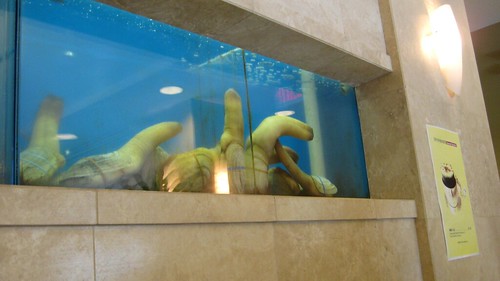
We trekked down to Richmond (20-30 minutes by car from downtown) to have some dim sum at Sun Sui Wah. When you walk in, fish are swimming in aquariums in the front. Immediately I was wishing I could go for dinner to order the seafood by the pound, particularly the oversized clam called geoduck (pronounced gooey-duck), or their famous roast squab. The dim sum is ordered from menus (which I actually prefer) and the restaurant was totally full even on a week day. The dim sum was very good. Really the only dish I didn’t think was above average was the fried squid that was cut into somewhat thick chunks. But given all that I’ve read about the amazing dim sum to be had in Vancouver (by far the best I’ve had was in Toronto) we were a little disappointed. The menu lacked the creativity and uniqueness we were expecting. With lower expectations we would have been impressed by the variety and quality of the dishes. The menu features most of the standard dim sum dishes and a couple variations like pan-fried dumplings with leeks and fried sesame balls with black sesame paste filling, and it was as good as any dim sum I’ve had in Boston, NY, SF, Sydney etc but nothing more than that.
http://www.sunsuiwah.com/
That night we did the Alibi Room and the Salt Tasting Room in Gastown. The Alibi room specializes in local beers. They offer a four beer flight option, which is a big plus in my book at any bar with a decent tap list. The lines were clean, the waitstaff were knowledgeable and the the beers spanned a wide variety of local options. It’s not very often that I look at a tap list where I have never heard of 90% of the options, but such is the state of the Canadian craft beer scene. A lot of their stuff doesn’t make it to the US. The beers themselves were kind of middle of the road. Their higher gravity options really lacked body and flavor compared to their American counterparts. The real stand outs were the ESB and IPA from Red Racer (brewed by Central City in the suburbs of Vancouver). Both featured excellent bouquet and a nice crisp hop profile. Apparently they sell their stuff in cans too, which is cool. They also featured two aged taps. One was an 18 month old barleywine that had mellowed very nicely and the other was a 12 year-old unblended lambic. The lambic smelled like crisp, green apples and was beautifully tart and refreshing. What a treat! They have a cellar that features primarily local barleywines and imperial stouts, so I suspect they’ll have many more aged options in the future. We had a great time at the Alibi Room, I recommend it to anyone looking to try some Canadian craft beers.
http://alibi.ca/
Salt Tasting Room
Pictured: Various plates of cheeses, meats and pickles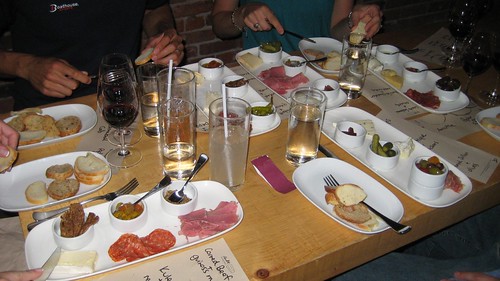
The Salt Tasting Room is kind of an interesting concept. 95% of what they serve you is made by someone else. They serve a huge variety of cheeses, charcuterie and wines and that’s about it. They took the idea of a wine and cheese party and turned it into a restaurant. They offer a three course option that starts with a salad, then a plate with your choice of three items from their cheese and meat menu with 3 condiments on the side, and a dessert. Also they offer a 3 wine flight option from their great, locally focused wine list. We were a group of 5, so by the time the table was filled up with our food we were able to try just about everything on the menu. It’s an interesting take on eating local. We had a great time sampling all the food and it all tasted good, but by the end you feel kind of weird paying someone to cut meat and cheese and put it on a plate for you. I see this as a great spot to snack after work and enjoy BC wine but maybe not so much a dinner destination in a city with so many great dining options.
http://www.salttastingroom.com/
Go Fish
Pictured: Fried salmon and chips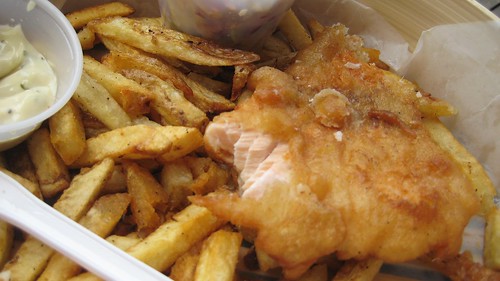
After a morning wandering around the Granville Island Market and kayaking we headed over to the famous fish and chips spot near the Island called Go Fish. The line was about 30 minutes and after ordering the fish took another 30 minutes because it’s battered and fried to order. The fish (halibut was in season) is very fresh and not overcooked in the fryer, a sign of a place that fries fish with care. However the batter is kind of plain and lacks the crispiness of great fried fish. The fries are standard, fresh fried but nothing special. The highlight for me was the scallop burger that featured 4 big, juicy grilled scallops on a bun with caramelized onions. I’m not sure this place was worth the line or the accolades, but it’s hard to argue with fresh fish, battered and fried to order, next to the water.
http://dinehere.ca/vancouver/go-fish
Tojo's
Pictured: Some mushroom dish
The final meal of the trip was the much heralded Tojo’s. This was, without question, the best sushi experience I’ve ever had. We were seated at the sushi bar and the chefs entertained us all night. Apparently Tojo wasn’t in the house that night, but his replacement, Hot Dragon, was an excellent host. The sushi bar is all omakase (chef’s choice) but it’s literally all you can eat. The first couple courses are cooked. It started with seared tuna in sesame wasabi sauce (Tojo’s signature dish) which was a huge portion of melt-in-your-mouth tuna served in a large, deep ceramic bowl. The other highlight of the cooked portion of the meal was the smoked sable fish. It was delicate and buttery, simple outstanding. After four courses, the rest was more typical sushi fare, though the quality was far from typical. Each roll was distinctive and artistic. Some rolls were served wrapped in a sweet crepe or cucumber, the hand rolls featured geoduck, Alaskan king crab and light, crispy shrimp tempura. And the sashimi were spectacular as well. Particular standouts were the albacore tuna and the cold smoked salmon. I loved that most of the fish were from fairly near by and I think it really reflected in the quality of the ingredients. After about 10 courses Hot Dragon would ask us if we wanted more after every course. We ended up getting 14 courses, though I’m certain they would’ve fed us 5 more if we wanted. Also a note on the ambiance. It’s a fairly expensive restaurant (150 CAD for omikase at the sushi bar) and the service is attentive but not superlative. But more interesting is that the restaurant doesn’t take itself seriously, at all. There was a group celebrating a birthday on the other side of the restaurant, and the waitstaff sang an off-key, ridiculous rendition of happy birthday. Also, we told them we were celebrating our anniversary and they gifted us a toenail clipper with Tojo’s written on it. I guess what I’m trying to say is that we had a great time goofing off with Hot Dragon, eating great sushi and laughing at his jokes. So it’s not a place for people prefer their sushi in a very serious and quiet environment. But for us, far from sushi experts, looking for a good time, Tojo’s was as good as it gets.
http://www.tojos.com/
-
-
Post #46 - October 12th, 2010, 7:15 amA quick note to say that we just returned from a way-too-short visit, our first. A post is in the making, but I just wanted to thank everyone who's posted in this thread for helping us make our choices. In the event, we had a couple okay breakfasts (Templeton and Deacon's Corner) and one excellent one (Medina Cafe); one fabulous lunch (Phnom Penh in Chinatown); and some interesting dinners (Zakkushi--thumbs up, Le Crocodile--thumbs up, Tojo's--thumbs down, and Rain City Grill-thumbs up). Oh, and tea at Bacchus in the Wedgewood Hotel. More, with pictures (I hope), soon.Gypsy Boy
"I am not a glutton--I am an explorer of food." (Erma Bombeck)
-
-
Post #47 - October 31st, 2010, 6:59 pmWhat a fabulous city—for eating, for sightseeing, for shopping, for mountains, for the water...you name it. Neither the Lovely Dining Companion nor I had ever been to Vancouver before. I eagerly await our return. We ate, we shopped, we walked, we ate, we hiked, we ate.... The people are friendly, the weather was good (at least most the time we were there), everything was terrific, although I wish some of the prices had occasionally been a bit less, well, pricey.
TOJO'S
We were glad to see that turkob, a couple posts upthread, had a great time here. And I start with Tojo's because it made a great impression on us, too. Negatively. We had heard nothing but how terrific this place is: Japanese food done right. Award upon award, impossible to get into, pricey but exquisite. Tojo claims to be the inventor of the California roll (a claim that appears to be disputed) and to say that he is venerated locally is an understatement. One wall is covered with some five or six dozen framed awards. But if you look close, virtually every award is local. That should have been the tip-off, although, to be scrupulously fair, there was a piece from Gourmet, a NYTimes write-up (Bittman, not Bruni), and Anthony Bourdain likes the place (but then, he knows Tojo). So who are we?
(I'm not quite sure of the significance of this—though I suspect that it has none. But it did not escape my notice that Forbes, the magazine that can't enough to do for its subscribers, has apparently compiled a list of "Top Ten World's Most Expensive Sushi" places. Tojo's ranks fourth, following Masa in NYC, Sushi-ko in Tokyo, and Miyako in Geneva. And no, I couldn't find an explanation of how they calculate this.)
In a word, disappointing. On second thought, I need a stronger word. We did not sit at the sushi bar (sometimes called the omakase bar because, as is pointed out above, you don't order there, you are served omakase-style)—although we certainly could have. Given all the hoopla and warnings we read before we went, it was remarkably easy to get a dinner reservation for a Friday evening a mere week ahead. More intriguing still, the restaurant was never full. Not even the vaunted sushi bar. Our reading—the place is written up in dozens of papers, blogs, and in foodie threads near and far (Google Tojo's and Vancouver and you'll get an amazing 31,900 results!)—led us to believe that Tojo is both a sushi master AND that his omakase is to die for.
The restaurant is a very large, post-modern room featuring a sushi/omakase bar that seats 15 where Tojo presides. When he's there. (He wasn't the night we were.) The servers are all Japanese; not of Japanese descent from Canada, but Japanese from Japan. Some are more proficient in English than others but all help give the place the right "feel" (due in part to the fact that they all wear kimonos or happi coats and have, or retain, fairly strong accents). I emphasize that because the food doesn't really contribute a lot to the feeling of Japanese-ness; it's often very Westernized Japanese food.
We each chose a different omakase. An omakase is supposed to be creative and it's supposed to be surprising...shocking even. This is the chef's opportunity to show off; to flaunt his knowledge, his expertise, his skill, his judgment, his entire being. Presentation is valued, if possible, even more highly than inventiveness or astonishing-ness.
Some have written that this restaurant is Tojo's effort to update or step beyond traditional Japanese food. Then why was almost everything so extraordinarily ordinary? There was little evidence in either of our dinners of much inventiveness or creativity. Neither dinner featured a single course with great imagination. Both dinners included high-quality ingredients composed with little imagination. Perhaps even more dismaying in its own way was the lack of devotion to presentation. Presentation is not only a key to Japanese food (and the Japanese esthetic generally), it's a hallmark of omakase. There was little about any of our courses that met the expectations usually attendant upon this kind of meal. Tojo's turns out to be the place to have an expense-account dinner (we saw a number of business execs in suits) or an "impress-your-date" place (we saw several younger couples). It is not a place where Japanese eat--either Japanese-Canadians, Japanese-Americans, or Japanese from Japan; there were few Asians of any ethnicity at all in the very large room, other than employees.
Tojo understandably features his own creations on the menu. But they are staid. You're not likely to find anything like Northern Lights, Great Pacific, or Celebration 2010 rolls in high-end places in Japan, nor miss them. Take Tojo's "Great Canadian Roll." Here's how the menu describes it: "East meets West: Atlantic lobster with asparagus inside with smoked Pacific salmon on top." We didn't have it and I have no reason to believe that it's anything but delicious. But creative? The presentations from which we expected so much were all neat and uncluttered. But they seemed more likely to have been drawn from a textbook than innovative or thought-provoking in any way. Shocking or breathtaking wasn't in the cards.
I chose the five-course omakase for $80. My courses: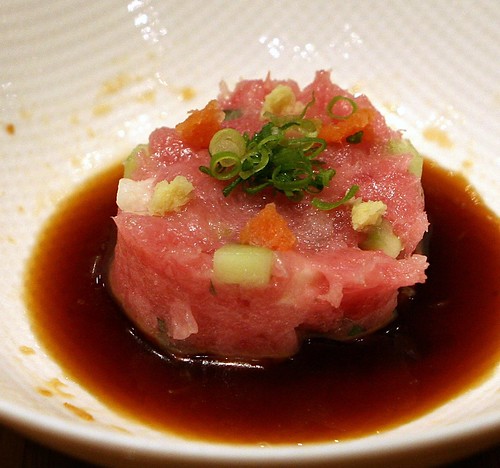
1) a too-large portion (about 3" in diameter and 1½" high) of finely chopped tuna with seven or eight pellets of sato imo (mountain potato), cucumber, and some green onion, all sitting in a puddle of ponzu with some shoyu. Why do I say "too large"? Because after a time, one tires—and one's palate tires—of eating it. As good as the tuna was, the sato imo and cucumber were simply too infrequent. This course relied almost entirely a single ingredient and it became boring after a while. I've had a similar dish elsewhere and high-quality tuna is the starting point, not the goal. What makes this dish sing is the choice of "add-ins" and how they complement the tuna. There just weren't enough other flavors or textures to intrude on mouthful after mouthful of tuna, good as it was.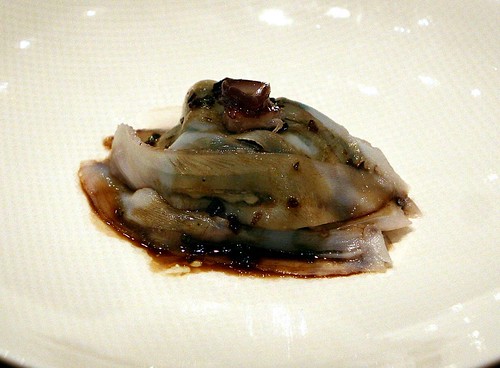
2) thin slices of lightly cooked octopus atop a bed of wakame, pickled daikon, and carrot, dressed with a slightly spicy sesame miso dressing. A very good course, possibly the highlight. Very fresh octopus (one raw sucker decorated the top) and good wakame.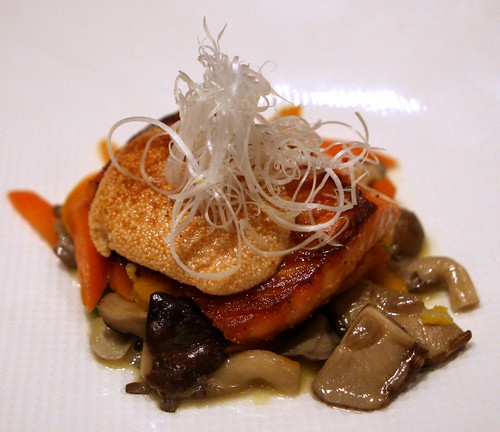
3) grilled salmon atop mixed veggies with a dollop of some kind of creamy roe (sorry, I didn't take notes). The roe is the sole thing that distinguishes this course from the identical item at too many other restaurants. A small fillet of grilled salmon? This is Vancouver where there are too many great chefs and top restaurants who have access to the same great quality fish. What did the chefs do to make this salmon stand out? They added some roe to it.
4) nori-wrapped red tuna with a tempura crust, topped with sauce made from ume (sour pickled plum). The tempura crust might have added some textural interest but it was effectively non-existent. I don't know if the kitchen didn't do a good job or the crust fell off or what happened. So we're left with tuna wrapped in nori. The second course in a row that, but for the missing tempura crust, felt more like a missed opportunity than anything else.
5) sushi (smoked salmon, scallop, (not sure of this one), tamago with tobiko (flying fish roe), and in the back, hamachi/yellowtail and unagi). The course featured very good fish and, while that is always appreciated, it's not like there's only one place to get great fish in Vancouver. I suppose a sushi course is almost inevitable in a situation like this and I can't find much fault with it but nothing about it was out of the ordinary or unexpected, not even the choice of fish.
6) dessert: a black sesame custard. Tasted definitively of black sesame. The problem is that I'm not sure that that's a good idea--it's not exactly a dessert flavor (at least not to my palate).
LDC's vegetarian ($70) omakase:
1) three small offerings: spinach, pickled daikon, and sliced asparagus and mushrooms (dressed with miso); these are what one would ordinarily expect (and receive) as Japanese version of an amuse in almost any other Japanese restaurant in the world...a little vorspeis to whet your appetite. All three were perfectly fine and perfectly ordinary.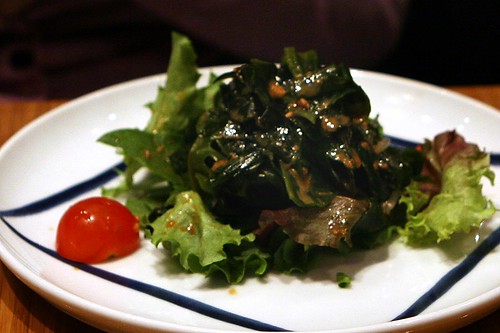
2) wakame salad atop organic greens with "house" dressing. Okay, fine. But then, it's kinda hard to mess this up very much.
3) a potato croquette atop mixed veggies with shoyu and miso sauces. This is street food in Japan. If you're going to serve street food, you ought to do something remarkable to it if you're going to make it part of a $70 omakase. Serving it over veggies is not something remarkable.
4) braised mushrooms with green onion in a hoisin-like sauce. Uh, okay. Good...even very good, but the course again begs the question: is this the best you can possibly do?
5) vegetarian sushi, including inari-zushi. Inari-zushi falls into the same category as a potato croquette. You can get this at any hole-in-the-wall. Why is Tojo serving this? What is he doing to it to make someone sit up and take notice? There was nothing "wrong" with the course and, as a sushi course, it was probably as expectable as the sushi course in my omakase. But it managed to maintain the theme of ordinariness.
6) dessert: fruit flavored ice creams. Couldn't he at least have found green tea (or adzuki bean) ice cream?
It is worth noting that there was nothing served at the beginning of the meal--no miso soup, no small plate of pickles, nothing whatsoever. There were no little extras at any point during the entire evening. Not even white rice was offered. Hell, notwithstanding these prices, they had the gall to charge for green tea. Green tea!
The only surprise of the evening (other than the major-league disappointment we both felt) was when the LDC sat straight up in her seat with a look of surprise on her face. The one "creative" touch of this cutting-edge chef was...he is pushing the envelope by putting pineapple in his sushi!
We can imagine lots of unusual/unexpected ingredients. But in a roll that features such cutting edge items as cucumber, asparagus, and carrot, why pineapple? Well, I'll give him this: pineapple certainly qualifies as unexpected! We'd be open to pineapple if there was something remarkable about the way he served it, the combination he served it with, the presentation. Something. Anything. But this was just a piece of pineapple (LDC suspects that it was canned, fwiw) in an otherwise completely ordinary piece of sushi. There was no challenge to the palate, to preconceptions, to anything. Given the asparagus and the cucumber, it didn't even offer a change in texture. Just laziness in an otherwise relentlessly ordinary sushi roll.
Now. Please go back and read the courses in that vegetarian omakase again. Seventy dollars for those courses? This is the omakase of a world-renowned chef? "Chutzpah" mixes our ethnicities, here, but $70 for those courses falls within my definition of chutzpah. Could we imagine a vegetarian omakase worth $70? Yes, without any doubt whatsoever. We don't object to paying the money for such a thing; heck, LDC would never have ordered it if we did. We can certainly imagine it. We just didn't get it. (Perhaps this is the place to note that Tojo's charges $16 for an a la carte salad of "organic greens" and $18 for wakame atop those greens. I guess we should have read the regular menu more carefully before we ordered.)
Let me summarize: good, occasionally very good, dishes, in terms of taste alone. But overall this was run-of-the-mill Japanese food. At these prices, inventiveness, creativity, quality, taste, presentation...everything should be spectacular. But it isn't. Even LDC's green tea was just okay. (I chose a 300 ml bottle of junmai ginjo from the sake list. $38 for 300 ml; it was good, he said, damning with faint praise.) Service was fine. This is probably where I should note that our server, and others we overheard, were not particularly comfortable using English. Servers are apparently instructed to explain things in detail without using a single word of Japanese. Things for which there was a single, simple Japanese word were translated into cumbersome, sometimes confusing, English. Had we not been familiar with the cuisine, I have no doubt that some of the disjointed descriptions would have misled us. While the dedicated effort to allow diners to understand exactly what is on their plates is admirable, inflexible rules like this fail because some situations simply beg for breaking the rules. Some translations into English became stilted because servers weren't able to use Japanese words. It was never a service issue but I can imagine that it creates confusion.
Outrageous prices, no miso, no gratis pickles, a charge for tea. Frankly, even if had we not been expecting so much, even if we had just discovered Tojo's walking down the street, our opinion would be the same. This is not the exceptional restaurant that it purports to be; not even a post-Japanese restaurant and even the excuse that Tojo takes pride in focusing on local sources (which, in turn, somewhat skews what he can do) doesn't wash. I read one writer who waxed lyrical about the individual grains of rice in his sushi and another who claimed that "Sushi in Japan did not come close to Tojo's." This is the kind of nutso devotion this place inspires. Having now spent well over $200 there, it beats us why. It may be that if Tojo is there personally and if Tojo wants, for whatever reason, to make certain that you enjoy your visit (hello Tony Bourdain), and if you are prepared to open your wallet unreservedly, then it may be that Tojo's is a very special place. When all those "if's" are met, I'll report in detail on that unique circumstance. But until then, I can't imagine recommending this place.
LE CROCODILE
A couple nights earlier, our second night in Vancouver, we walked over to this place. I purposely chose it over Daniel Boulud's Lumière. This is old-school French, right down to a waiter fresh off the calvados boat (or whatever boat arrives from France bearing waiters). Although the room is large, it's cozy and, though we were there on a Thursday evening, it was full. Completely full. And deservedly so. The chef is Alsatian, much of the serving staff is French direct from France, and everything about it is Old World. If you don't want that, this isn't the place for you.
Crabcake (amuse bouche)
Offered as an amuse was a very small, luscious crabcake. Drawing on the rich bounty locally available to chefs in this city, this was a great introduction to the restaurant and the evening. The cake was filled with crab and just barely enough binder to keep it together. From the quality of the crab to the generous proportion in each little cake, from the flavor to the perfect rendition (not greasy or oily in the least), this was a great starter. And, aside from one major miscue (for which I must share the blame), dinner would prove to be excellent.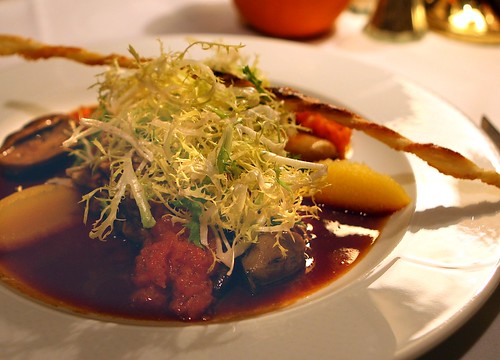
Veal sweetbreads with porcini, turnip purée
Following the crabcake LDC opened with a slice of Alsatian onion tart that could have fed several people. Rich, sweet caramelized onions in a delectable crust. There may well be better examples in Alsace, but this version would please all but the most demanding. It struck a perfect balance between the opulence of the rich, sweet onions and a light airy custard. The only downside was the almost overgenerous portion. We should all have such dilemmas. I opted for veal sweetbreads with porcini mushrooms in a citrus reduction. The presentation was superb and the taste lived up to the presentation.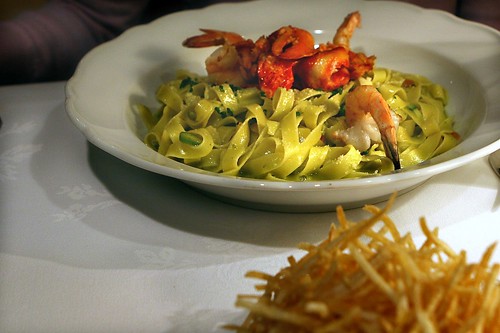
Fettucine with lobster and prawns
For our entrees, LDC chose fettuccine with lobster and tiger prawns and I ended up with Provençale-style lamb shanks with roasted garlic and a tomato fondu. LDC professed herself to be quite happy with her dinner despite lobster which she said was (dismayingly) not particularly sweet. The prawns, apparently, were highly satisfactory. My lamb shanks were very lamb-y (a plus in my book), quite meaty, and nicely done indeed. The richness of the lamb was cut by the acid of the tomatoes and the sweetness of the plentiful roasted garlic was a nice foil as well. (In the foreground of the picture you can see a dish of the most remarkable frites delivered to every table. As the picture hints, the plate was heaped high with these delectable, perfectly fried, thin crisp beauties.)
Lamb shanks
Service was always prompt and we rarely needed to summon anyone to ask for anything. No one hovered and everyone knew his or her assignment. Indeed, visits were just often enough to ensure a smooth flow and make certain that we didn't want anything. Our only real complaint would be that it would have helped to have a server a bit more at ease in English; I tried to switch the conversation to French at one point where English temporarily left us at an impasse, but the server seemed bound and determined to get through it in English or not at all. So we eventually worked through it.
Dessert: sorbets for the LDC and a classic of the Old School for moi: Grand Marnier soufflé. I can't even recall the last time I saw it on the menu. I couldn't imagine doing this more than once a year, frankly. But it has probably been at least a decade since I even had this, possibly two. So I thought, why not? And their preparation was as nearly perfect as I can imagine. Light, flavored with Grand Marnier but not reeking of it, just crusty enough on top, and exactly the right portion. If I have a criticism it would be that while I appreciated the little pitcher of crème anglaise, I would have appreciated it even more had the server not poked a hole in the soufflé and poured the entire contents of the pitcher in without asking. But the soufflé itself was so perfect that I am even willing to overlook this gaffe.
RAIN CITY GRILL
It was, appropriately, raining pretty hard during our last dinner in Vancouver. This is a place known for both seafood and for locally sourced products. It's not a particularly large place but it has long had a great reputation in Vancouver for its seafood and its "Northwest" cuisine. It sits close to the water and would have offered great views of the mountains across English Bay but for the fog and rain (two provincial parks lie just outside North Vancouver). Still, it was dark and cozy inside and we looked forward to this, our last dinner in this great town.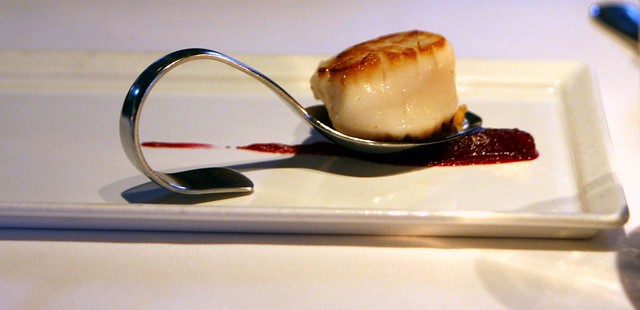
Seared scallop and bacon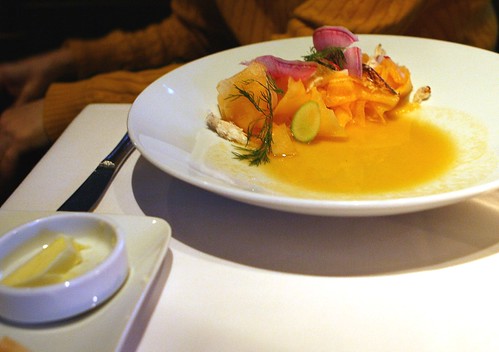
Melon and crab salad
Having already eaten four meals so far this day, LDC's appetite was flagging, so she went with a "spoon" and an appetizer: a seared scallop with a bacon "sauce" and a melon/crab salad. Both won high praise, though the ratio of melon to crab was declared to be somewhat less than desirable. Still, the meaty crab and the sweet melon made a nice match and a fitting meal.
I chose to begin with scallops as well. My choice, though, was a couple seared scallops atop a melted leek risotto (that's a carrot foam in the picture). Meaty, firm, luscious, fresh scallops. This is why going local is so edifying--short of eating these on the boat, it's hard to imagine much fresher seafood. The leek risotto was more leek than risotto, but it turned out to be a tastier complement than I feared.
For my entree, braised lamb cheeks with caramelized fennel (that's an eggplant "sauce" painted on the plate). I guess this is one of those things either you like or not: lamb seems to be one of those divisive tastes. LDC isn't a fan, lucky for me. No shared tastes! The lamb was everything one could ask: beyond fork tender (somehow "meltingly tender" doesn't seem quite right as a descriptor and my command of the language fails me in describing just how fall-apart good this lamb was), opulantly, luxuriously rich and flavorful. Not overly lamby in the way that some can be, just packed with (pardon the borrowing here) lamby goodness. Not having the opportunity to have locally-sourced lamb all that often, I can't say for certain that this was a factor in my appreciation, but given the extraordinarily wide variety of things that were local here (scallops to lamb in one meal is a pretty broad range), I'm thankful whatever the cause.
PHNOM PENH
Phnom Penh is in a somewhat dingy corner of Chinatown and it serves Vietnamese and Cambodian food. It is enormously popular and in order to get in without spending the afternoon waiting, we agreed to share a table. We soon found ourselves at a table with a young mom and her two young kids and a middle-aged couple. Everyone was friendly. The young mom offered us a number of shopping tips and the kids took part in the conversation when they weren't busy devouring what was in front of them. The husband was very curious about us, though we suspect his wife didn't speak English. Indeed, at one point, he chewed out the staff because our food took longer than he thought it should to be delivered. (We believe that the delay was owing to what we ordered, not to any desire to single us out.) The large room was filled with families and couples, indeed, most of the tables and booths served a minimum of four or six. And there was a large group waiting as we left.
It's no wonder. This was excellent food. Nothing fancy, but great food wonderfully prepared. LDC ordered trieu chau (steamed dumplings with Lop cheong, pork, gingko nuts, jicama (we think), hard-boiled egg, topped with cilantro) and I had a mok, sometimes one word. Both were on the first page of this multi-page menu under "House Specials." Mine is a staple of Cambodian food (I didn't know this at the time) and amounted to seafood stewed in a coconut milk/lemongrass/galangal broth. The standard preparation is with fish, though it can also be made with chicken. Knowing all that now, I like the way I had it: a generous assortment of many different kinds of seafood. The best way I know to explain this restaurant is this: if it were in Chicago, it would have been a GNR for years by now.

Trieu chau (photo courtesy of this blog)
(There has been some debate on this board about whether a restaurant packed with people who are the same ethnicity as the menu is a good sign or a bad sign. In general, my own sense is that it's a good sign, though not without exceptions. You may disagree with me but this trip only reinforced my prejudice: until the very end of our lunch, I was the only white person in a jam-packed Phnom Penh. And we were about the only people speaking English, at least to judge by all the nearby tables. LDC, on the other hand, was one of a very few people of Asian descent in Tojo's.)
ZAKKUSHI
Sato imo (deep-fried mountain potato) and the "dipping sauce" of finely powdered green tea (salty)
Takoyaki (grilled octopus with plenty of toppings, an Osaka specialty; a wonderful snack)
A cozy izakaya with enjoyable food. They have three locations and we can't speak to the others. We went to the one on Denman Street after walking up and down the street examining dozens of options. This is not a place that serves great food, but most izakayas are known for their atmosphere in any event. The food was very well made, well-seasoned, and we enjoyed almost every one of the many courses we ordered. It's worth noting that the menu was quite large and, unlike, say, Tojo's, the food was Japanese without being Westernized in the least.
Mochi isobe (grilled mochi--sticky rice--wrapped in nori with soy sauce)
Out of this world! What a perfect combination: the gooey sticky rice, slightly sweet with the hint of the sea from the seaweed and the salt of the shoyu. New to me and to die for.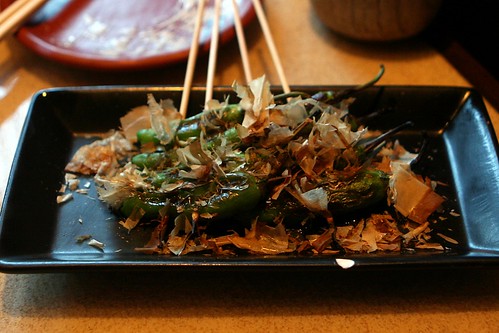
Shishitou (grilled peppers topped with katsuobushi (shaved dried bonito))
These mild peppers reminded me of padron peppers without the occasional really hot one. They're lightly charred and you eat the entire thing, seeds and all. A nice interlude.
No compromises on ingredients, flavors, presentation, or anything else. That said, there are plenty of items on the menu that, even for those who are less-than-familiar with this kind of food, is quite accessible and non-challenging (in a textural or flavor context).
MEDINA CAFE
If you're ready for vividly flavored North African food for breakfast, this is the place. (To be sure, they have two or three good ol' Murican options like waffles or oatmeal, but that's not why you go to breakfast here. Sure, you can get fish at a steakhouse, but why would you?) One of the best breakfasts I can recall in a long time. Unexpected menu, some of the best coffee I've had in years, and busy as all get-out on a weekday morning.
By way of illustration, here's just a few dishes from the menu (I should add that the menu is not overlarge by any means. Still, even with a short list of items, I had a lot of trouble choosing):- Paella One baked egg, curried orzo, hungarian chorizo, zucchini, red pepper, roast corn, grano padano, avocado and tomato salad. $12
Cassoulet 2 fried eggs on baked beans, saucisson de Paris, double smoked bacon and andouille. Grilled foccaccia. $15
Libanais Soft boiled egg, cucumber tomato salad, baba ganoush, tabouleh. Fried pita bread. $12
Tagine Poached eggs, spicy tomato stew, red pepper, merguez sausage, moroccan olives, cilantro. Grilled foccaccia $14
I overcame my inhibitions, ordered the tagine, and enjoyed an amazing, well-seasoned dish. It's refreshing to come across a kitchen that doesn't steer toward the safe middle in its seasoning. Absolutely terrific dish. The merguez was firm, spicy, generously sized, and worked perfectly. The eggs, peppers, and merguez sat in the tomato "stew." That stew was, again, brightly seasoned, from luscious ripe tomatoes and...well, golly, just perfect.
I need to plug the grilled foccaccia as well. Yeah, it's just bread and yeah, it comes with a number of the dishes. But this is foccaccia cut like Texas toast and as light and fluffy as you would never expect. Drizzled with a bit of balsamic. Where have you been all my life?
You can get a couple "standard" Western-style breakfast items, including a small but apparently exceptional waffle, or oatmeal, or even an omelette. But you can get those many places. You can't find this set of choices elsewhere and if you find yourself in Vancouver and even mildly curious, I can't encourage you too much. But go early; it's small and if you're not there fifteen minutes after they open, you'll be eating somewhere else.
Tagine (photo courtesy of this blog)
BACCHUS (for high tea)
Bacchus is just off the main lobby of the Wedgewood Hotel, around the corner from the Vancouver Art Museum. I can't speak to the hotel's furnishings, but the tea is served in the bar--which isn't quite as incongruous as it seems, although there were a couple of large screen televisions which didn't really add to the ambiance. We chose a table that allowed us to look toward the fireplace (and the day we visited it was cold and rainy and the fire was a wonderful sight). There are big overstuffed leather chairs. Plenty of dark wood and decor from your grandmother's house. And then there's the tea service. The LDC and I always try to work in a high tea no matter where we go; it's civilized, it's fun, and it's usually pretty delicious, too. While this may not be my all-time favorite (I'm thinking that that honor goes to Lake Louise or Banff, although we've had some pretty great teas in a lot of places, including right here in Chicago), it was exceedingly well-done.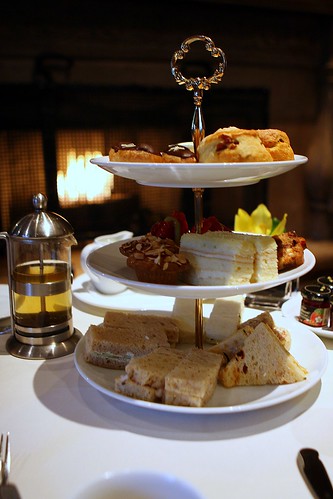
In fact, this is one of the first times I can recall being at tea and thinking to myself, "There's too much food." I'm used to a wide variety but here there was not only variety but a surfeit. Just too much. Three kinds of sandwiches (egg salad, cucumber, and chicken salad); two kinds of scones; small (not tiny) éclairs; fruit tarts; nut cakes; and other cakes. The tea selection was broad but not deep and we were both happy with our selections. Just a little disappointed at the forced confluence of sports on the large televisions and high tea....
Now then. I've skipped some meals: our breakfasts at Templeton and Deacon's Corner, for example, were perfectly ordinary examples of diner food. Good, but nothing worth singling out. We had other meals elsewhere that were likewise good, but not noteworthy. Still, if you add up the number of meals and the number of days we were there
ODDS AND ENDS
The title should, by no means, be understood to detract from the fabulous time we had at the Granville Island Public Market. It's far from the largest public market we've been to and there wasn't a great deal that we haven't seen elsewhere, but it was an impressive place nonetheless. Because of Vancouver's terrific geographic location, everything from astonishing seafood to "The Mushroom Man" to the standard fruits, veggies, meats, breads, and pastries was on display. It looked like pretty much all high quality stuff and we were only sad that we had so little opportunity to avail ourselves of the riches there. (Not to mention the second public market across the water in North Vancouver at Lonsdale Quay.) And here we sit in Chicago, a city about six times the size of Vancouver and we don't have anything to match it. Sad.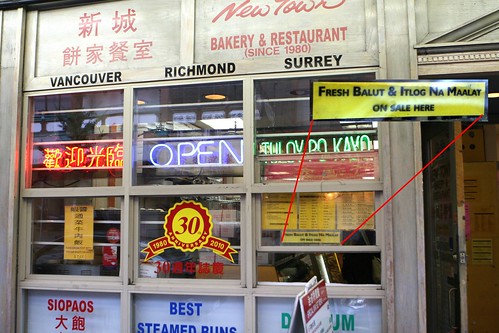
This was a first for me. I almost did a double-take when I saw this small sign in the window....
CUPCAKES was a place we were curious to try; the press has been great and hey, who doesn't love a great cupcake? Fortunately for us (since it was still raining), the store was directly across the street from Raincity Grill. So we popped in just as they were in close-up-for-the-night mode. They were not happy to have customers and it showed. Matter of fact, their unhappiness fairly reeked. Too bad, 'cause the red velvet cupcake was one hell of a cupcake and we'd be happy to recommend the place otherwise. But such crappy attitude is really depressing.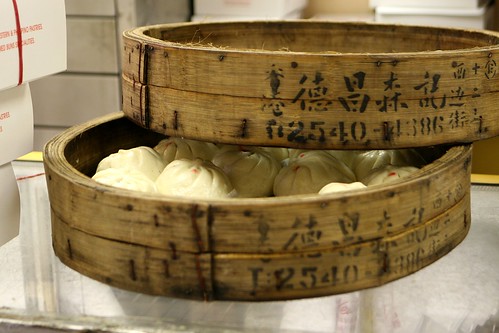
As anyone who has ever been to a Chinatown anywhere knows (and I imagine that's virtually everyone on this board), stopping in all the shops is not only fun, but fascinating, educational, informative, entertaining, and often delicious. So as we poked our heads into a bakery to get a couple to-go snacks, I happened to spy these old steamer trays on the counter. Couldn't resist the picture. What do you think?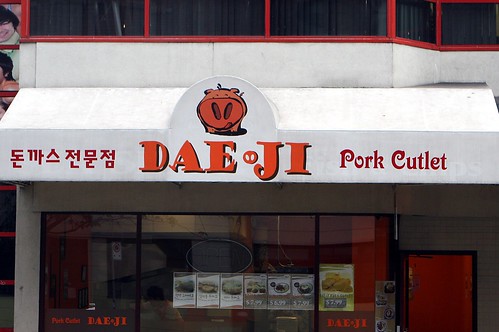
Although this place was highly recommended upthread, we just couldn't squeeze in another morsel at the time. But what a great awning!
All of which leaves me with that perennial question: why does food taste so much better on vacation? The good places are better; the great places, greater (and even the mediocre places somehow better), or at least it seems that way. The only plausible explanation I've managed to come up with--fabulous local sources aside--is that it is, obviously, vacation. Nowhere we have to be in two hours. Nothing to do when we get home. Nowhere to be tomorrow. No work coming up. Even more than when we go out to eat at home, we're relaxed. But there's really so many things that go into enjoying a meal from atmosphere to physical comfort to sounds and sensations, service, not to mention the taste of the food itself. We may be more relaxed on vacation, but that still leaves all those other factors over which we have so little control. So even acknowledging the relaxation factor, is the service, ambiance, taste, sounds and sensations really so much better when we're away from home? Beats me.
Tojo's
1133 W. Broadway
(604) 872-8050
http://www.tojos.com
Le Crocodile
909 Burrard (at Smithe)
(604) 669-4298
http://www.lecrocodilerestaurant.com
Raincity Grill
1193 Denman Street
(604) 685-7337
http://www.raincitygrill.com
Phnom Penh
244 Georgia St E
(604) 682-5777
(no website but plenty on the internet)
Zakkushi
823 Denman Street
(604) 685-1136
http://www.zakkushi.com
Medina Cafe
556 Beatty Street
(604) 879-3114
http://www.medinacafe.com
Bacchus (Wedgewood Hotel)
845 Hornby Street
(604) 608-5319
http://www.wedgewoodhotel.com
P.S. For all of you who never really outgrew Peter Pan and have always wanted to learn to fly, here's the place: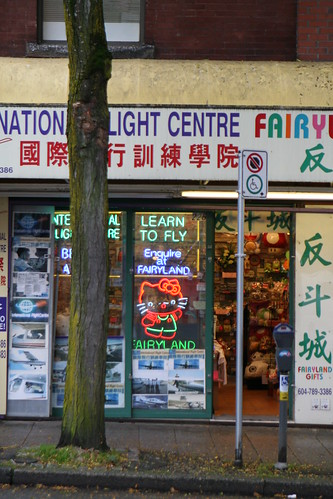 Last edited by Gypsy Boy on June 20th, 2017, 1:10 pm, edited 2 times in total.Gypsy Boy
Last edited by Gypsy Boy on June 20th, 2017, 1:10 pm, edited 2 times in total.Gypsy Boy
"I am not a glutton--I am an explorer of food." (Erma Bombeck)
-
-
Post #48 - August 17th, 2011, 11:08 amOur Alaskan cruise ended in Vancouver, so the wife and I decided to spend a few days exploring the city. Some places we ate...
Tojos - An incredible experience. We sat at the sushi bar and Tojo was there that night so that certainly added to the experience. Tojo is quite the trip, not pulling punches with any of his opinions. The fish was mind-blowing. Yasuda-level good. The meal was a nice split between composed dishes and individual pieces which really showed off the full range of what Tojo does. Some highlights were a dungeness crab salad, house smoked salmon, impossibly buttery toro, and a yellow eye snapper that Tojo finished me off with. Not a cheap night out by and means, but well worth it for the experience.
Izakaya - We did Kingyo, Zakkushi, Hapa, and Guu. The tan tan noodles at Kingyo were one of the highlights of our entire trip. We also had some black cod cheeks at Kingyo that were outstanding. Skewers were the main focus at Zakkushi, with the cod roe with spicy mayo coming in as my favorite (just beating out the chicken hearts). Hapa seemed more about the scene, the food was just fine. Guu was a total trip. It was like walking into some combination of a rowdy party and a Japanese game show. Fortunately they take their food pretty seriously and this made for a nice last stop. This time a fillet of black cod was the standout. It literally melted in our mouths.
Blue Water Cafe - The best seafood restaurant I've been to in a long time. Oysters, sushi, composed fish dishes, shellfish...everything was spectacular. I had a whole dungeness crab for my main course that was huge and packed with meat. Oysters before dinner were perfectly shucked and incredibly fresh tasting. This is a can't miss restaurant if you're in Vancouver.
Japadog - We spend most of one day at Grouse Mountain. On the way back, after getting off the Seabus, we spotted a Japadog stand located outside the terminal.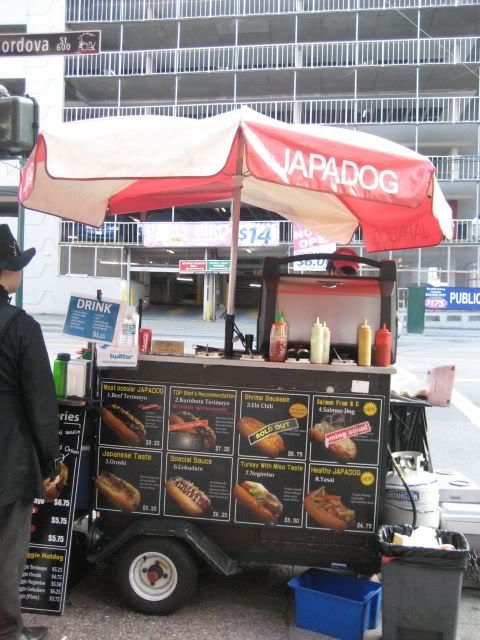
We stopped for one as a snack and boy am I glad we did. An unholy combination of a beef hot dog, topped with shredded nori, onions, and a teriyaki/mayo sauce all cooked on a grill on the stand (the bun gets toasted too). Just a fantastic hot dog. So good in fact we made Japadog out last meal of the trip (they have a location that was right across from our hotel). On that Japadog run I tried another variety that included a Kurobuta pork sausage and dried bonito flakes. Wonderful.
Granville Island - We checked out the island including the huge market. The produce, meat, and seafood all looked terrific but I wasn't really nuts about most of the actual eating options (I passed up bagels filled with smoked meat which I immediately knew was a mistake). A chocolate crunch donut from Lee's was probably the highlight. We also did a sake tasting at a craft sake brewery located just outside of the market, which was a lot of fun.
A great weekend in a great city.
-
-
Post #49 - April 28th, 2013, 4:26 pmI had dinner Wednesday evening as part of a large convention group at LIFT, which is described by Tapler above in 2008. It was a preset menu to accommodate the size of the group. It was really one of the better large scale dinners of that type which I've attended. The highlights included a scallop appetizer and a main course of sturgeon in a rich dark sauce. I also enjoyed the pre-selected wine, though I couldn't say what is was. Service was very attentive and personable.
As indicated by Tapper, the view is spectacular. It is right on the harbor, so that view is wonderful, but there is also a great view of the city which can be seen from the upper outside deck which is complete with a fire pit. The views, of course, are dependant on clear whether which we were fortunate to have, but which cannot always be counted on in Vancouver."I live on good soup, not on fine words." -Moliere
-
-
Post #50 - February 9th, 2014, 6:34 pmI started this thread way back before a trip with the kids. Well, my wife and I finally made it back with the kids (take that, sonofjonah!). Here's were we ate in this still fantastic city:
Bel Cafe: Vancouver has an amazing selection of cafes. This one is run by the same team that owns Hawksworth, one of the top find dining locations. We had a late afternoon snack and breakfast there, mainly eating cookies and pastries, which are all terrific.
Yew: Rated the second best seafood place by Vancouver magazine (second to BlueWater Cafe), this snazzy room in the Four Seasons is using local seafood to great effect. The appetizer was a dungeness crab taco we won't soon forget.
Thierry: A fabulous french patisserie/cafe, with croissants as good as I can recall. Also had a great Montreal smoked beef sandwich (smoked beef, slaw and mustard on a bagette) for lunch. We went back a second time.
Wildebeast: Rate the best new restaurant of 2013 by Vancouver magazine, this place would fit right in on Randolph Street. Open kitchen, some communal tables and lot's of creative, excellent cooking with local ingredients. The highlight was a sweetbread dish with almond butter; who know those two things went together?
The Coffee Bun: If by any chance you take the seabus across to North Vancouver (and you should; the ride is spectacular), there is a mall on the other side with a blah looking food court. But right outside the ferry stop, just outside the mall, is The Coffee Bun, serving fantastic homemade, coffee flavored Asian style buns, but somehow crunchy on the outside and gooey in the middle.
Whistler: Araxi is one of the top rated places there, and it was a very good fine dining restaurant.
-
-
Post #51 - August 5th, 2015, 7:28 pmAny recent recommendations? I plan to eat XLB in as many places as possible. Also the market at Granville Island and Guu with Garlic. If I can dig deep, Tojo for omikase.
Replies appreciated!Man : I can't understand how a poet like you can eat that stuff.
T. S. Eliot: Ah, but you're not a poet.
-
-
Post #52 - April 11th, 2016, 4:27 pmI neglected to post on our tasty trip to Vancouver. We loved Guu with Garlic (thanks Amata). Though I cannot recall exactly what we ordered, everything was delicious. My husband pronounced the place "LTH-y" and I am pretty sure that was a compliment. YEW, the restaurant at the Four Seasons serves rich, smoky chowder and crispy Dungeness tacos that made for a decadent lunch. The bar is very pleasant. Their breakfast menu was also quite interesting with a merguez sausage option, likely a ripoff of the Medina meal mentioned upthread by Gypsy Boy. Forage turned out one of the tastiest burgers I can recall, though I can't tell you why I ordered a burger at the local, sustainable spot with many vegetarian options. It seems like a really popular spot on a popular food street. They seem to be known for brunch, so I would line up a reservation. I was glad that I ran across the Eater Vancouver Top 10 Before You Die Ramen Map. The chicken-based ramen at Marutama Ramen was as unctuous as a porky ramen bowl - memorably so. Thank you, jesteinf for the Blue Water Cafe recommendation. It was the West Coast meal I was hoping for. The website shows a large restaurant. We sat on a lovely terrace and ate oysters and then halibut and Arctic Char.
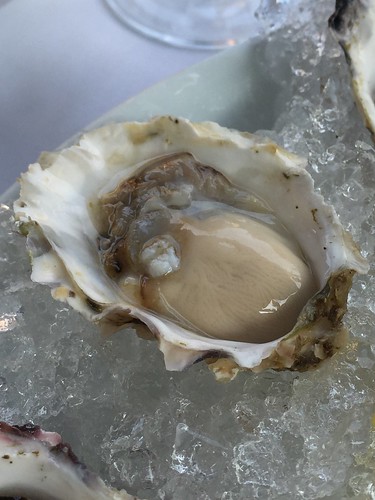 Oyster
Oyster  Halibut with Chanterelles
Halibut with Chanterelles 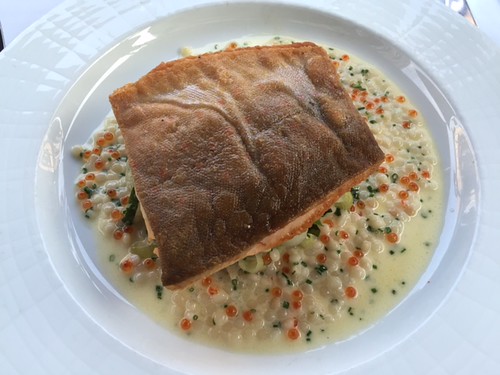 Arctic Char
Arctic Char
The little orange things floating in the beurre blanc are bits of salmon roe amid pearls of Israeli couscous. With a crowd on a special occasion, one of the seafood towers would be a wonderful choice - lots of people were splurging on those and they looked fresh and generous.
A chow trip always has its share of regrets. We could not get in to TOJO and I could live with that. But missing the Chili Crab at the now-closed Prima Taste was indeed a disappointment, after the compelling description from Cooler by the Lake. However, in my work for this post, I now see that there is a video of the chef making Chili Crab on YouTube. If I can line up the crab here in STL, I am in business!
Next: Richmond, BC and XLBMan : I can't understand how a poet like you can eat that stuff.
T. S. Eliot: Ah, but you're not a poet.
-
-
Post #53 - December 1st, 2016, 12:44 pmI'll be downtown for a conference next week--any strong recs for Chinese food in the area?
-
-
Post #54 - December 1st, 2016, 1:25 pmNo Chinese, but inbetween a train and a cruise ship,
we had an AMAZING tea service at the Fairmont!
Recommend so highly!
I'll try to find my pix
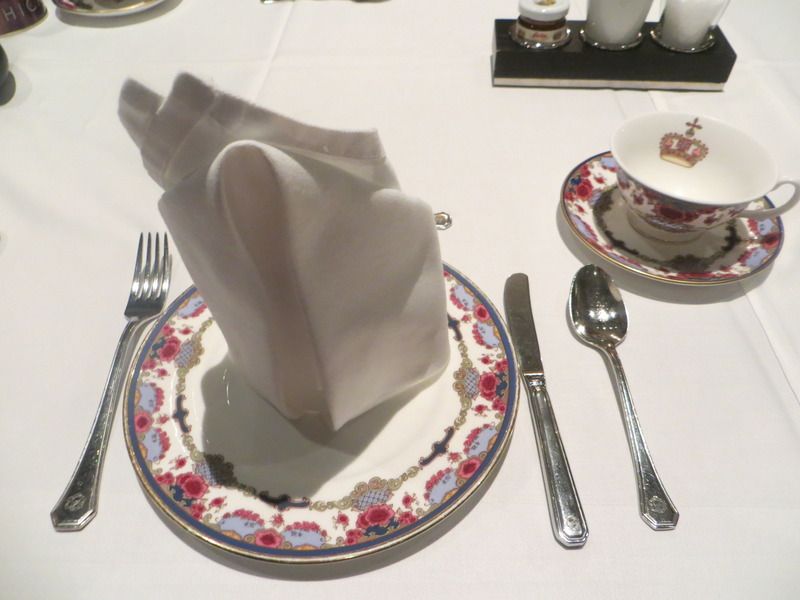
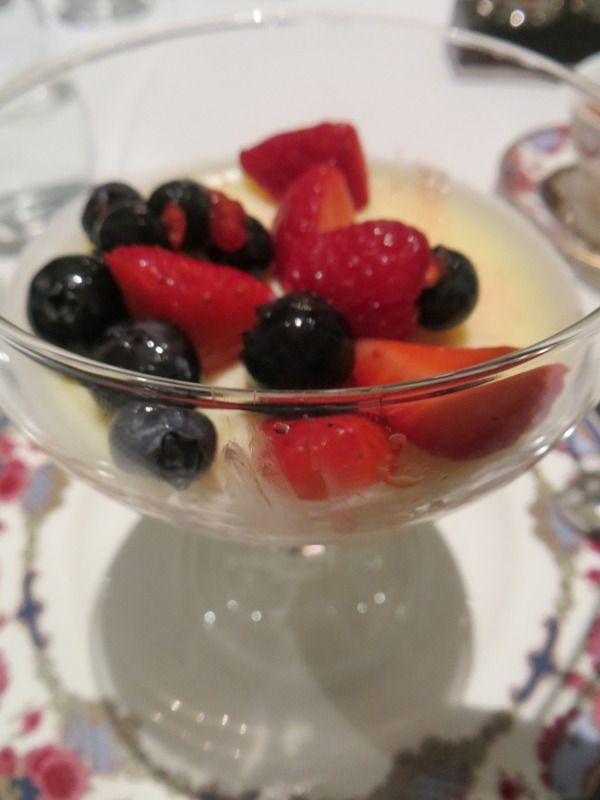
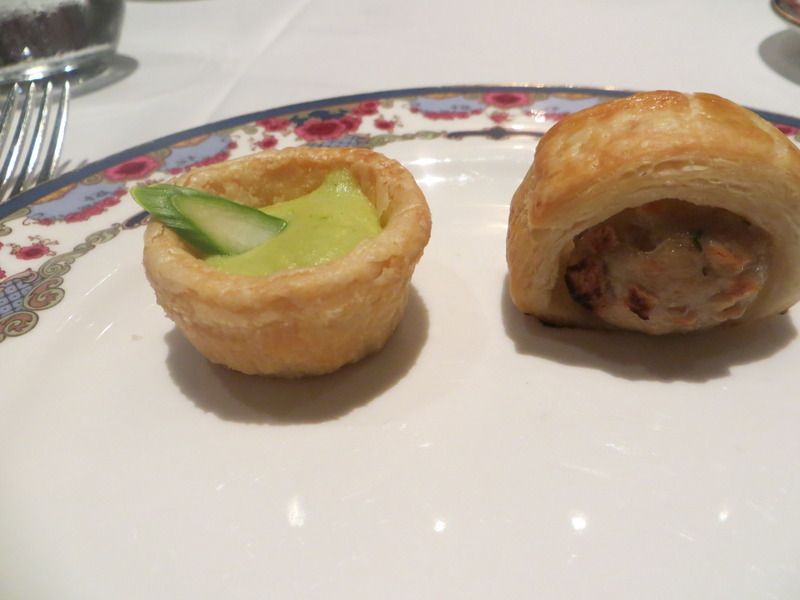


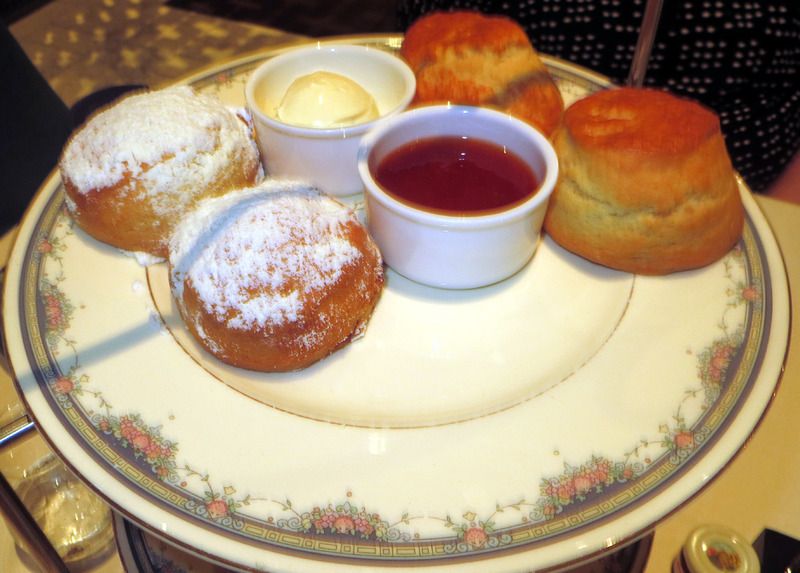
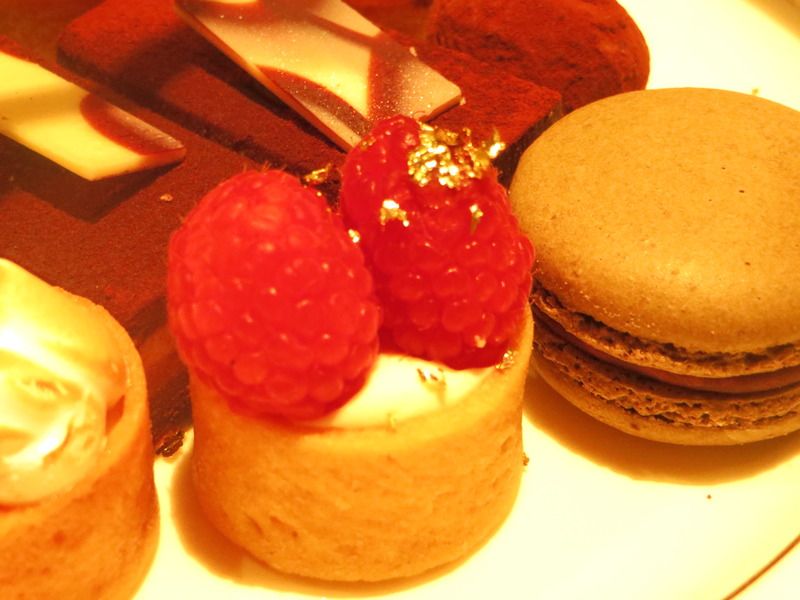
Everything was so elegant and so delicious! We were stuffed for hours!"If you reject the food, ignore the customs, fear the religion and avoid the people, you might better stay home."
~James Michener
-
-
Post #55 - April 25th, 2017, 1:20 pmBriefly: Returned to Blue Water Cafe for this season's special: halibut. Very special. Curiously but deliciously sauced with chicken essence. Then, had the best sandwich in memory at Meat & Bread, porchetta with chimichurri and lots of crispy pork skin on a ciabatta roll. Great Northern Thai and killer cocktails & mocktails at Maenam. Next door to Maenam is the 31 Flavors of the new millenium, Rain or Shine, with the bonus of many GF and vegan options. Outstanding black sesame and lemon lavender ice creams among many others. We passed on Medina - an hour and 45 minute wait was just too long. Hotel find: Times Square Suites on Robson -excellent on all counts.
Blue Water Cafe
Phone: 604 688 8078
1095 Hamilton Street (@ Helmcken)
Yaletown, Vancouver BC
Meat & Bread (3 locations)
370 Cambie Street
at Victory Square
Vancouver, BC V6B 1H7
http://meatandbread.ca
or
1033 West Pender St
Downtown
Vancouver, BC V6E 2M6
and Seattle, too!
Maenam
1938 West 4th Avenue
Vancouver, BC V6J 1M5
PHONE: 604 730 5579
LUNCH TUES – SAT 12:00PM – 2:00PM
DINNER DAILY 5:00PM – 10:00PM
http://maenam.ca
Rain or Shine Ice Cream
http://rainorshineicecream.com
3382 Cambie Street Vancouver, BC V5Z 2W5
T. 604.876.9986
or
1926 West 4th Ave Vancouver, BC, V6J 1M5
T. 604.428.7246Man : I can't understand how a poet like you can eat that stuff.
T. S. Eliot: Ah, but you're not a poet.
-
-
Post #56 - June 17th, 2017, 10:06 pmWe just returned from a 6 day/5 night stay. As I benefited greatly from perusing this thread before we left, I will add a few data points. Thanks to all the previous posters.
Six Acres - really good small plates place. Liked the atmosphere, music, service. The crabcake sliders were elevated by the addition of house pickled vegetables. We also enjoyed their marinated olives and grilled asparagus.
Chambar- can't say enough about this place. Although we did not eat an actual meal here, we stopped by for a nightcap on our first night in town (a Sunday.) The bartender was so friendly and knowledgeable. He guided me to the perfect glass of wine and suggested a great dessert. From hostess to bartender to manager - everyone we encountered here made us feel extremely welcome even though we were not spending big bucks. We came back on our last night (a Thursday) and while it was much busier, the bartender remembered us an sent out mignardes after we'd enjoyed another drink/dessert.
Robeson Street Guu with Garlic/Banana Leaf - we sat outside @ Guu and found it less chaotic/loud than the indoor dining room. Really enjoyed the grilled calamari appetizer and the sashimi salad. We then headed across the street for entrees. Seafood Laksa @ Banana Leaf was truely awesome. Wanted a straw for the liquid. Highly recommend.
The Flying Pig - hipster scene that was enjoyable. We shared tender fried calamari and I had a seafood pappardelle that was perfectly prepared.
Steamworks - fresh mussels with a nice coconut curry broth. Just spicy enough to make it interesting without being overpowering. Enjoyable Summer Ale.
Alibi Room - wow. Really enjoyed this space. We stopped in for drinks before dinner elsewhere. Jonathan did a beer flight and I chose a wine after a lengthy consultation with our server. She came up with a perfect choice. We shared some edamame that was dusted with toasted sesame in addition to some sea salt. I am a huge fan of edamame as a drinking snack and will take it over nuts/chips any day.
Medina- had our last meal of the trip here and were not disappointed. Is there a comparable place here in Chicago? I hate sweet breakfast items and begin most days with dark rye toast spread with hummus and topped with cherry tomatoes and arugula. So Medina was right up my alley. Loved the veggie paella. Note to RAB/REB, they definitely had drip coffee. We sat at the counter and enjoyed the entertainment of watching the barista at work. We arrived at 9:45 and had a 30 minute wait. It was worth it. People arriving at 10-10:15 were
quoted 1 hour to 1 hour & 15 minutes. To me, not worth it. Plan accordingly.
So, after many years of benefiting from LTH tips I am finally offering one of my own here. One of our servers highly recommended an Italian spot in Railtown. It's tiny (maybe 10 tables,) and I truly do not have the words for how much I enjoyed the dinner experience. Service, food, wine, ambiance, music, vibe...all came together in a way that only special places do. The place is "Ask For Luigi". It's a favorite with Vancouver restaurant industry workers. Go.
-
-
Post #57 - July 23rd, 2017, 9:11 pmLynnB's post made me realize that I had "forgotten"to mention the coffee at Revolver. I must have "forgotten" to mention the spot-on tasting notes for the pour-overs and the outstanding pastries that we lingered over for the better part of an hour. They had a cool selection of coffee paraphernalia, including a travel-sized Aeropress Porlex travel espresso maker that works with pressure of suction, rather than with electricity (Amazon $51)- I am using it now with Porlex JP-34570006 hand-powered coffee grinder and getting good results. Revolver's location is in Gastown.Man : I can't understand how a poet like you can eat that stuff.
T. S. Eliot: Ah, but you're not a poet.
-
-
Post #58 - October 4th, 2018, 3:02 pmIn Vancouver on business.
On arrival, grabbed a Japa-Dog just outside the airport terminal. Great snappy casing, the sweet teriyaki and Kewpie mayo strangely work. I'd definitely do it again (not so sure about the Wagyu Dog with Brussels Sprouts).
Last night, we went to Guu with Garlic, great place, felt like Tokyo with the servers shouting orders to the cooks and loudly greeting and thanking patrons when they leave.
I didn't remember to grab photos of everything (my boss kept plying me with sake), but I'll try to remember everything we ate.
Sake:
We had the Guu Van Go Funk! and a second one whose bottle I can't read. The Van Go Funk was awesome: yeasty, fruity with just a floral hint, that I usually only get with a cloudy-style sake. I'd buy some, but it's a Guu exclusive. The second was also pretty good, but a little harsher.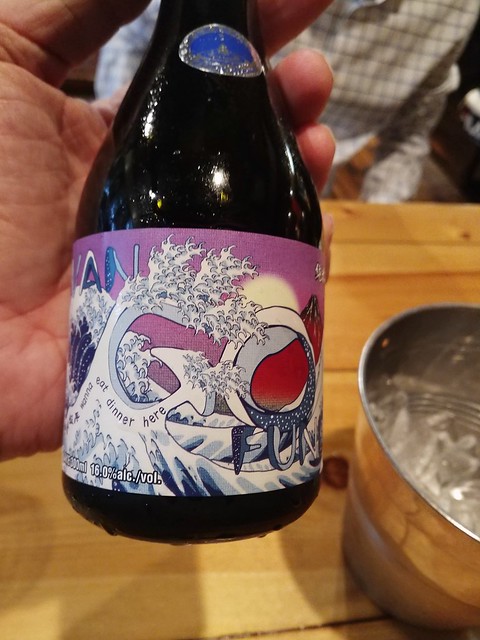
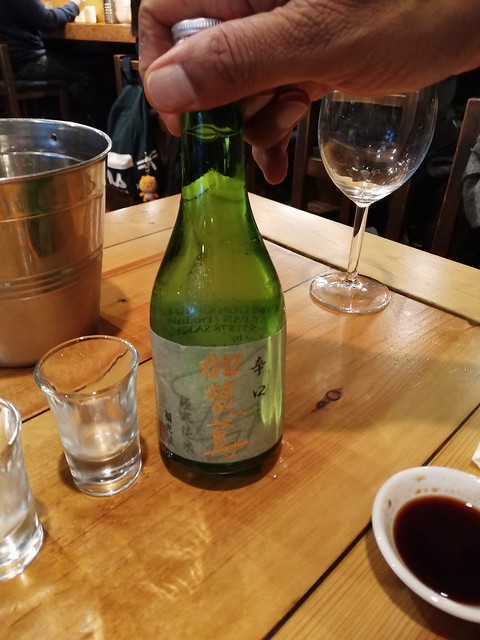
First round of plates included edamame; the garlic shrimp below -- my boss asked for extra fried garlic, which proved a nice addition to a lot of the other dishes too; and tofu yakko, tonight's version topped with enoki mushrooms. The latter a little bland (not pictured).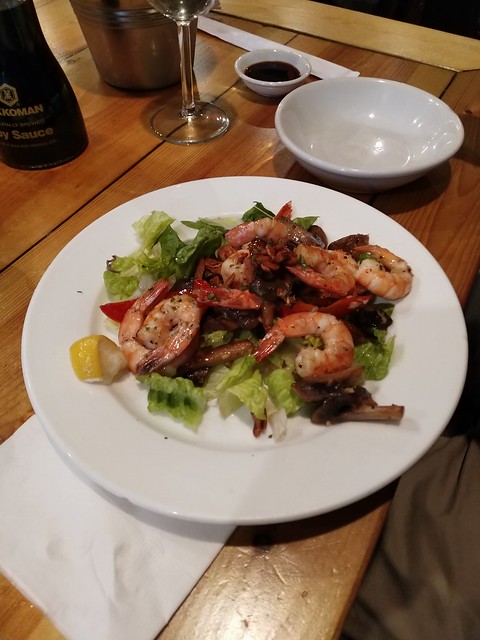
Second batch included Tokujyo Harami, grilled hanger steak; Tontorro, grilled pork cheek; Sake-steamed mussels with garlic butter (awesome)
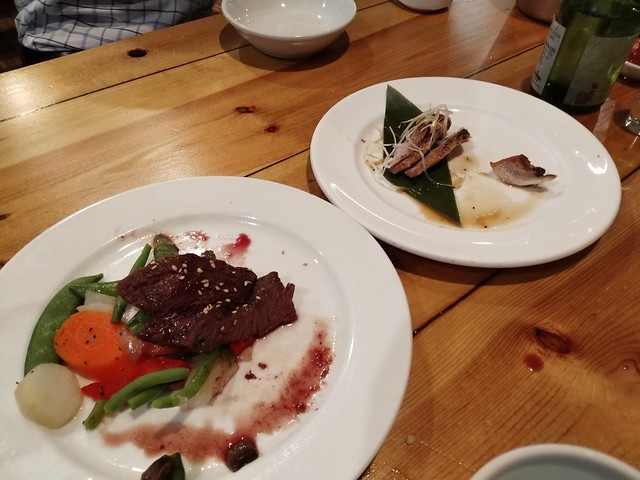
The last batch included Spicy Poke Don (tuna), and Taco Rice which featured ground pork and cheese -- a real hit, with a bit of cumin and toasty rice from the hot stone bowl (sadly not pictured, but once it was mixed up really wasn't that pretty)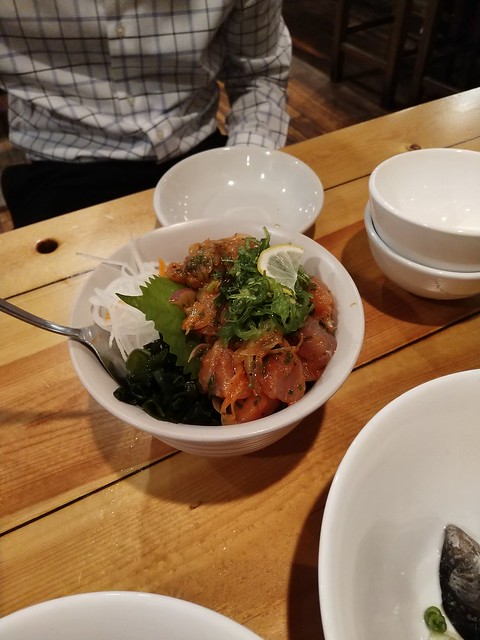
Hospitality was top-notch (although it was a little slow between the first and second set of dishes, which were ordered together), great atmosphere, great food.
Guu with Garlic
1698 Robson Street, Vancouver, B.C. V6G 1C7
TEL:604-685-8678
https://guu-izakaya.com/location/What is patriotism, but the love of good things we ate in our childhood?
-- Lin Yutang
-
-
Post #59 - October 5th, 2018, 10:49 amLast night, went to Kirin based on a far up thread rec for dim sum. I get there and no dim sum at dinner, everything else is quite expensive, and they sat me next to two maniac kids running and jumping so I left.
If Kirin is the old Big Three Happiness (fancy decor dim sum), two doors down is Neptune Noodle Bar as Little Three Happiness. Cheap, noisy and effective, as a friend of mine described The Clash. Didn't order much as a solo diner:
Mushroom and Truffle dumplings had a wonderful gelatinous wrapper from glutinous rice, and a great mushroom and truffle umami hit. A little splash of soy and perfect.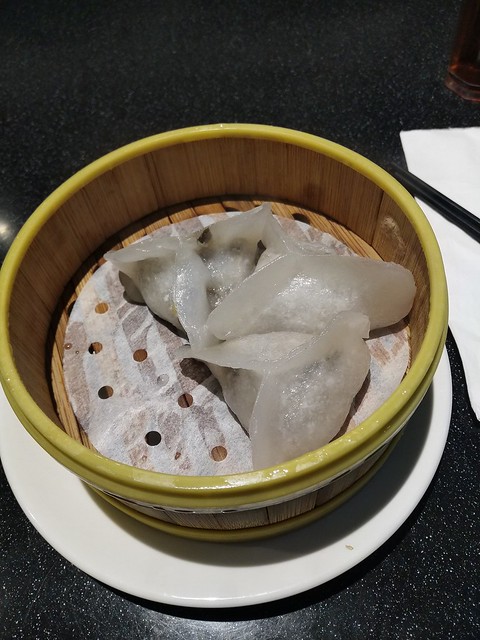
Salt and peppery [sic] spareribs were terrific too: bits of crispy, bits of fatty, bits of meaty, and chopped ginger, scallion and green chile and Sichuan peppercorn.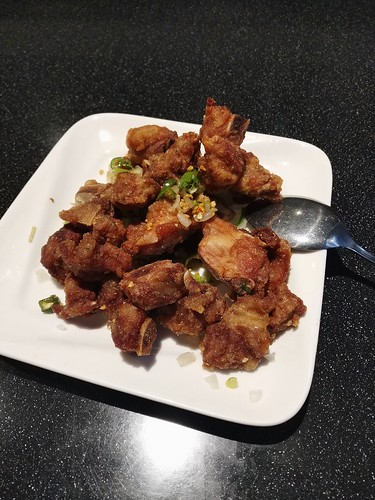
Chile oil full of lots of good goop too.
Neptune Chinese Kitchen
1136 Alberni St, Vancouver, BC
(604) 229-5789
http://www.neptunechinesekitchen.comWhat is patriotism, but the love of good things we ate in our childhood?
-- Lin Yutang

